Effects of Land-Use Practices on Woody Plant Cover Dynamics in Sahelian Agrosystems in Burkina Faso since the 1970s–1980s Droughts
Abstract
:1. Introduction
2. Methodology
2.1. Location of the Study Area
2.2. Evolution of Woody Plant Cover
- : pixel values of the near-infrared band
- : pixel values of the red band
- pixel values of the blue band
- : gain factor, G = 2.5
- L: ground reflectance correction factor, L = 0.5
- correction coefficients of the aerosol diffusions, C1 = 6, C2 = 7.5.
2.3. Sampling
- = the number of observation sites;
- the proportion of the considered site;
- the margin of error resulting from the estimation of any other parameter calculated from the observations, a value of 8% is considered;
- = the value defined by the normal law according to the desired confidence level, a 95% confidence level value for a value of = 1.96 is considered.
2.4. Data
2.4.1. Rainfall
2.4.2. Soils
2.4.3. Geomorphology
2.4.4. Land Use and Land Cover
2.4.5. Land-Use Practices
2.5. Data Analysis
- is the regional precipitation index for a year ;
- is the regional precipitation average of the year
- is the inter-annual average of the regional precipitation;
- is the standard deviation of regional precipitation
3. Results
3.1. Evolution of Rainfall in the Study Area
3.2. Environmental Characteristics of Observed Sites
3.3. Landscape Characteristics of Observed Sites
3.4. Land-Use Practices
3.5. Relationship Between Woody Plant Cover Change and Rainfall
3.6. Relationship Between Woody Plant Cover Change and Environmental/Anthropogenic Variables
3.6.1. Woody Plant Cover Change and Geomorphology
3.6.2. Woody Plant Cover Change and Land Use, Land Cover
3.6.3. Woody Plant Cover Change and Land-Use Practices
4. Discussion
5. Conclusions
Author Contributions
Funding
Acknowledgments
Conflicts of Interest
Appendix A. Description of Land-Use Practices Observed that Affect Tree Dynamics
| Practices | Descriptions | Role in Trees Regeneration and Development |
|---|---|---|
| Assisted natural regeneration | Assisted natural regeneration is to protect and maintain forest species growing naturally in farms or natural areas |
|
| Animal parking in the farm | Animal parking in the farm consists of nightly stocking of cattle, sheep, and goats on farm to improve the manure stock in dry season and fallow land intended for cultivation the following year in the rainy season |
|
| Earth bunds | Earth bunds are compacted earth structures in the form of low walls aligned along the contour lines generally |
|
| Fallow | Fallow-land consists of leaving land under agricultural holding for a longer or shorter period of time |
|
| Grass strips | Grass strips are biological barriers made up of herbaceous plants (Andropogon gayanus, Andropogon ascinodis, and Pennisetum pedicellatum generally), installed in farms following the contour lines generally |
|
| Half-moons | Half-moons are structures of compacted earth or stones in the shape of a semicircular with openings perpendicular to the direction of water flow and arranged in quincunxes; the earth inside the half-moons is enriched in organic manure |
|
| Zaï | Zaï consists of digging pits of 0.7 to 1.2 m distance during the dry season, introducing organic manure and then waiting for the rains to disseminate the agricultural seeds in the middle of these pits |
|
| Mulching | Mulching consists of covering the soil with a layer of grass (Loudetia togoensis generally) or with branches or crop residues (millet or sorghum) to ensure soil cover |
|
| Organic amendments | Organic amendments consist of the application of organic manure coming from cowsheds, composting, and household waste |
|
| Planting | Tree planting consists of planting seedlings on farms or sylvopastoral areas |
|
| Stone dyke barriers | Stone dyke barriers are mechanical structures composed of stones placed upstream of a gully head to stop the gully erosion and allow a lowland farming |
|
| Stones row | Stones rows are mechanical structures composed of stones aligned along contour lines generally |
|
| Vegetated earth bunds | Vegetated earth bunds are compacted earth structures in the form of low walls aligned along the contour lines generally and associated with woody or grassy strips |
|
| Vegetated Stones row | Vegetated stones rows are mechanical structures composed of stones aligned along contour lines generally and associated with woody or grassy strips |
|
| Woody strips | Woody strips are biological barriers consisting of trees and shrubs, installed in farms following the contours lines |
|
| Practices | Descriptions | Role in Trees Regression |
|---|---|---|
| Agricultural expansion | Agricultural expansion consists of clearing a wooded area of trees to increase the cultivated area of an existing farm or to develop a new farm |
|
| Bush fires | Bush fires are fires of natural (lightning) or human (intentional or unintentional) origin that spread over forested areas |
|
| Gold panning | Gold panning refers to the artisanal gold mining and research activities that sometimes occurs in wooded areas |
|
| Pasture | Pasture refers to the extensive breeding of sheep, goats, and cattle in sylvopastoral areas |
|
| Urban development | Urban development here refers to the expansion of cities at the expense of wooded areas |
|
| Wood harvesting | Wood harvesting refers to the exploitation of firewood for household consumption needs mainly |
|
References
- Bonnecase, V. Retour sur la famine au sahel du début des années 1970: La construction d’un savoir de crise. Polit. Afr. 2010, 119, 23–42. [Google Scholar] [CrossRef]
- Brandt, M.; Romankiewicz, C.; Spiekermann, R.; Samimi, C. Environmental change in time series–An interdisciplinary study in the Sahel of Mali and Senegal. J. Arid Environ. 2014, 105, 52–63. [Google Scholar] [CrossRef]
- Doso-Jnr, S. Land degradation and agriculture in the Sahel of Africa: Causes, impacts and recommendations. J. Agric. Sci. Appl. 2014, 3, 67–73. [Google Scholar] [CrossRef]
- Thiombiano, A.; Kampmann, D. Biodiversity Atlas of West Africa, Volume II: Burkina Faso; Druckerei Grammlich: Pliezhausen, Germany, 2010; p. 592. [Google Scholar]
- Reij, C.; Tappan, G.; Belemvire, A. Changing land management practices and vegetation on the Central Plateau of Burkina Faso (1968–2002). J. Arid Environ. 2005, 63, 642–659. [Google Scholar] [CrossRef]
- Botoni, E.; Reij, C. La Transformation Silencieuse de L’environnement et des Systèmes de Production au Sahel: Impacts des Investissements Publics et Privés Dans la Gestion des Ressources Naturelles; Centre for International Cooperation (CIS)/Comité permanent Inter-États de Lutte contre la Sécheresse dans le Sahel (CILSS): Ouagadougo, Burkina Faso, 2009; pp. 1–63. [Google Scholar]
- Reij, C.; Tappan, G.; Smale, M. Agroenvironmental Transformation in the Sahel: Another Kind of “Green Revolution”; IFPRI Discussion Paper 00914; International Food Policy and Research Institute: Washington, DC, USA, 2009. [Google Scholar]
- Zampaligré, N.; Fuchs, L.E. Determinants of Adoption of Multiple Climate-Smart Adaptation Practices in Sudano-Sahelian Pastoral and Agro-Pastoral Production Systems. Sustainability 2019, 11, 4831. [Google Scholar] [CrossRef]
- Anyamba, A.; Tucker, C.J. Analysis of Sahelian vegetation dynamics using NOAA-AVHRR NDVI data from 1981–2003. J. Arid Environ. 2005, 63, 596–614. [Google Scholar] [CrossRef]
- Olsson, L.; Eklundh, L.; Ardö, J. A recent greening of the Sahel-trends, patterns and potential causes. J. Arid Environ. 2005, 63, 556–566. [Google Scholar] [CrossRef]
- Epule, E.T.; Peng, C.; Lepage, L.; Chen, Z. The causes, effects and challenges of Sahelian droughts: A critical review. Reg. Environ. Chang. 2014, 14, 145–156. [Google Scholar] [CrossRef]
- Bamba, A.; Dieppois, B.; Konaré, A.; Pellarin, T.; Balogun, A.; Dessay, N.; Kamagaté, B.; Savané, I.; Diédhiou, A. Changes in Vegetation and Rainfall over West Africa during the Last Three Decades (1981-2010). Atmos. Clim. Sci. 2015, 5, 367–379. [Google Scholar] [CrossRef] [Green Version]
- Epule, T.E.; Ford, J.D.; Lwasa, S.; Lepage, L. Climate change adaptation in the Sahel. Environ. Sci. Policy 2017, 75, 121–137. [Google Scholar] [CrossRef]
- Herrmann, S.M.; Hutchinson, C.F. The changing contexts of the desertification debate. J. Arid Environ. 2005, 63, 538–555. [Google Scholar] [CrossRef]
- USGS. Satellite Image Data Source. 2017. Available online: https://glovis.usgs.gov/app (accessed on 17 April 2017).
- Hiernaux, P.; De-Leeuw, P.N.; Diarra, L. Modelling tillering of annual grasses as a function of plant density: Application to Sahelian rangelands productivity and dynamics. Agric. Syst. 1994, 46, 121–139. [Google Scholar] [CrossRef]
- Brandt, M.; Hiernaux, P.; Rasmussen, K.; Mbow, C.; Kergoat, L.; Tagesson, T.; Ibrahim, Y.Z.; Wélé, A.; Tucker, C.J.; Fensholt, R. Assessing woody vegetation trends in Sahelian drylands using MODIS based seasonal metrics. Remote Sens. Environ. 2016, 183, 215–225. [Google Scholar] [CrossRef] [Green Version]
- Huete, A. A soil-adjusted vegetation index (SAVI). Remote Sens. Environ. 1988, 25, 295–309. [Google Scholar] [CrossRef]
- Huete, A.; Didan, K.; Miura, T.; Rodriguez, E.; Gao, X.; Ferreira, L. Overview of the radiometric and biophysical performance of the MODIS vegetation indices. Remote Sens. Environ. 2002, 83, 195–213. [Google Scholar] [CrossRef]
- Jamali, S.; Seaquist, J.; Eklundh, L.; Ardö, J. Automated mapping of vegetation trends with polynomials using NDVI imagery over the Sahel. Remote Sens. Environ. 2014, 141, 79–89. [Google Scholar] [CrossRef]
- Yao, R.; Wang, L.; Huang, X.; Chen, X.; Liu, Z. Increased spatial heterogeneity in vegetation greenness due to vegetation greening in mainland China. Ecol. Indic. 2019, 99, 240–250. [Google Scholar] [CrossRef]
- Gandhi, G.M.; Parthiban, S.; Thummalu, N.; Christy, A. Ndvi: Vegetation Change Detection Using Remote Sensing and Gis-A Case Study of Vellore District. Procedia Comput. Sci. 2015, 57, 1199–1210. [Google Scholar] [CrossRef]
- Jamali, S.; Jönsson, P.; Eklundh, L.; Ardö, J.; Seaquist, J. Detecting changes in vegetation trends using time series segmentation. Remote Sens. Environ. 2015, 156, 182–195. [Google Scholar] [CrossRef]
- Dagnelie, P. Statistiques Théoriques et Appliquées. Tome 1: Statistique Descriptive et Bases de L’influence Statistique; De Boeck et Larcier: Paris, France; Brussells, Belgium, 1998. [Google Scholar]
- ANAM-BF. Données Pluviométriques; Agence Nationale de la Météorologie: Ouagadougou, Burkina-Faso, 2017. [Google Scholar]
- CPC. Africa Rainfall Climatology (ARC2) Version 2.0 Data. 2017. Available online: https://www.cpc.ncep.noaa.gov/ (accessed on 17 April 2017).
- ORSTOM. Carte Pédologique de Reconnaissance de la République de Haute-Volta, Échelle: 1:500,000; Centre ORSTOM de Dakar; Office de la Recherche Scientifique et Technique Outre-mer: Dakar, Sénégal, 1973. [Google Scholar]
- Bationo, B.A.; Kalinganire, A.; Bayala, J. Potentialités des Ligneux Dans La Pratique de L’agriculture de Conservation dans les Zones Arides et Semi-Arides de l’Afrique de l’Ouest: Aperçu de Quelques Systèmes Candidats; ICRAF Technical Manual N°17; World Agroforestry Centre: Nairobi, Kenya, 2012. [Google Scholar]
- Mbow, C.; Smith, P.; Skole, D.; Duguma, L.; Bustamante, M. Achieving mitigation and adaptation to climate change through sustainable agroforestry practices in Africa. Curr. Opin. Environ. Sustain. 2014, 6. [Google Scholar] [CrossRef]
- Nyamekye, C.; Thiel, M.; Schönbrodt-Stitt, S.; Zoungrana, B.; Amekudzi, L. Soil and Water Conservation in Burkina Faso, West Africa. Sustainability 2018, 10, 3182. [Google Scholar] [CrossRef]
- Ali, A.; Lebel, T.; Amani, A. Signification et usage de l’indice pluviométrique au Sahel. Sécheresse 2008, 19, 227–235. [Google Scholar] [CrossRef]
- Hair, J.F.J.; Black, W.C.; Babin, B.J.; Anderson, R.E. Multivariate Data Analysis; Pearson: London, UK, 2014; p. 734. [Google Scholar]
- Fensholt, R.; Sandholt, I.; Rasmussen, M.S. Evaluation of MODIS LAI, fAPAR and the relation between fAPAR and NDVI in a semi-arid environment using in situ measurements. Remote Sens. Environ. 2004, 91, 490–507. [Google Scholar] [CrossRef]
- CPCS. Classification des sols; Commission de Pédologie et de cartographie des sols: France, 1967; p. 87. Available online: http://horizon.documentation.ird.fr/exl-doc/pleins_textes/divers16-03/12186.pdf (accessed on 12 May 2019).
- Cardarelli, F. Materials Handbook; Springer: London, UK, 2008. [Google Scholar]
- Sherratt, J.A. Using wavelength and slope to infer the historical origin of semiarid vegetation bands. Proc. Natl. Acad. Sci. USA 2015, 112, 4202–4207. [Google Scholar] [CrossRef] [Green Version]
- Baartman, J.E.M.; Temme, A.J.A.M.; Saco, P.M. The effect of landform variation on vegetation patterning and related sediment dynamics. Earth Surf. Process. Landf. 2018, 43, 2121–2135. [Google Scholar] [CrossRef] [Green Version]
- Gerardin, V.; Ducruc, J.P. An objective approach to evaluating natural drainage of forest mineral soils for non-specialists. Vegetatio 1990, 87, 127–133. [Google Scholar] [CrossRef]
- Xu, M.; Dong, X.; Yang, X.; Chen, X.; Zhang, Q.; Liu, Q.; Wang, R.; Yao, M.; Davidson, T.; Jeppesen, E. Recent Sedimentation Rates of Shallow Lakes in the Middle and Lower Reaches of the Yangtze River: Patterns, Controlling Factors and Implications for Lake Management. Water 2017, 9, 617. [Google Scholar] [CrossRef]
- Sanou, L.; Savadogo, P.; Ezebilo, E.E.; Thiombiano, A. Drivers of farmers’ decisions to adopt agroforestry: Evidence from the Sudanian savanna zone, Burkina Faso. Renew. Agric. Food Syst. 2019, 34, 116–133. [Google Scholar] [CrossRef]
- FAO. Lignes Directrices Pour la Gestion Durable des Forêts en Zones Arides d’Afrique Subsaharienne; Document de travail sur les les Forêts et la Foresterie en zones arides No. 1; FAO: Rome, Italy, 2010. [Google Scholar]
- Breu, T.; Hurni, H.; Portner, B.; Schwilch, G.; Wolfgramm, B.; Messerli, P.; Herweg, K.G. Sustainable Land Management and Global Development: Factors Affecting Land Users’ Efforts to Adopt and Sustain the Productive Use of Natural Resources. In Research for sustainable Development: Foundations, Experiences, and Perspectives; Wiesmann, U.H.H., Ed.; Perspectives of the Swiss National Centre of Competence in Research (NCCR) North-South, University of Bern; Geographica Bernensia: Bern, Switzerland, 2011; pp. 427–449. [Google Scholar]
- Carter, N.H.; Viña, A.; Hull, V.; McConnell, W.J.; Axinn, W.; Ghimire, D.; Liu, J. Coupled human and natural systems approach to wildlife research and conservation. Ecol. Soc. 2014, 19. [Google Scholar] [CrossRef] [Green Version]
- Hull, V.; Tuanmu, M.-N.; Liu, J. Synthesis of human-nature feedbacks. Ecol. Soc. 2015, 20. [Google Scholar] [CrossRef] [Green Version]
- Ghazoul, J. Deforestation and Land Clearing. In Encyclopedia of Biodiversity, 2nd ed.; Levin, S.A., Ed.; Academic Press: Waltham, MA, USA, 2013; pp. 447–456. [Google Scholar]
- Shoko, C.; Dube, T.; Sibanda, M.; Gumindoga, W. In-depth analysis of the impacts of rural population growth on the natural environment: A GIS and remote sensing approach In-depth analysis of the impacts of rural population growth on the natural environment: A GIS and remote sensing approach. Trans. R. Soc. S. Afr. 2015, 70, 149–153. [Google Scholar] [CrossRef]
- INSD. Annuaire Statistique 2015; INSD: Ouagadougou, Burkina Faso, 2016. [Google Scholar]
- Reij, C.; Garrity, D. Scaling up farmer-managed natural regeneration in Africa to restore degraded landscapes. Biotropica 2016, 48, 834–843. [Google Scholar] [CrossRef]
- Petrosillo, I.; Aretano, R.; Zurlini, G. Socioecological Systems. Encycl. Ecol. 2015, 4, 419–425. [Google Scholar] [CrossRef]
- Elsawah, S.; Pierce, S.A.; Hamilton, S.H.; Van-Delden, H.; Haase, D.; Elmahdi, A.; Jakeman, A.J. An overview of the system dynamics process for integrated modelling of socio-ecological systems: Lessons on good modelling practice from five case studies. Environ. Model. Softw. 2017, 93, 127–145. [Google Scholar] [CrossRef]
- Bégué, A.; Vintrou, E.; Ruelland, D.; Claden, M.; Dessay, N. Can a 25-year trend in Soudano-Sahelian vegetation dynamics be interpreted in terms of land use change? A remote sensing approach. Glob. Environ. Chang. 2011, 21, 413–420. [Google Scholar] [CrossRef]
- Huber, S.; Fensholt, R.; Rasmussen, K. Water availability as the driver of vegetation dynamics in the African Sahel from 1982 to 2007. Glob. Planet Chang. 2011, 76, 186–195. [Google Scholar] [CrossRef]
- Gonzalez, P.; Tucker, C.J.; Sy, H. Tree density and species decline in the African Sahel attributable to climate. J. Arid Environ. 2012, 78, 55–64. [Google Scholar] [CrossRef] [Green Version]
- Borja, M.E.L. Climate Change and Forest Natural Regeneration in Mediterranean Mountain Areas. For. Res. 2014, 3, e108. [Google Scholar] [CrossRef]
- Bose, A.K.; Weiskittel, A.; Wagner, R.G.; Kuehne, C. Assessing the factors influencing natural regeneration patterns in the diverse, multi-cohort, and managed forests of Maine, USA. J. Veg. Sci. 2016, 27, 1140–1150. [Google Scholar] [CrossRef]
- Brandt, M.; Rasmussen, K.; Hiernaux, P.; Herrmann, S.; Tucker, C.J.; Tong, X.; Tian, F.; Mertz, O.; Kergoat, L.; Mbow, C.; et al. Reduction of tree cover in West African woodlands and promotion in semi-arid farmlands. Nat. Geosci. 2018, 11, 328–333. [Google Scholar] [CrossRef]
- Rovero, M. Nutrient Cycling Causes and Impacts of Desertification. Ref. Modul. Earth Syst. Environ. Sci. 2017. [Google Scholar] [CrossRef]
- Kusserow, H. Desertification, resilience, and re-greening in the African Sahel-a matter of the observation period? Earth Syst. Dyn. 2017, 8, 1141–1170. [Google Scholar] [CrossRef]
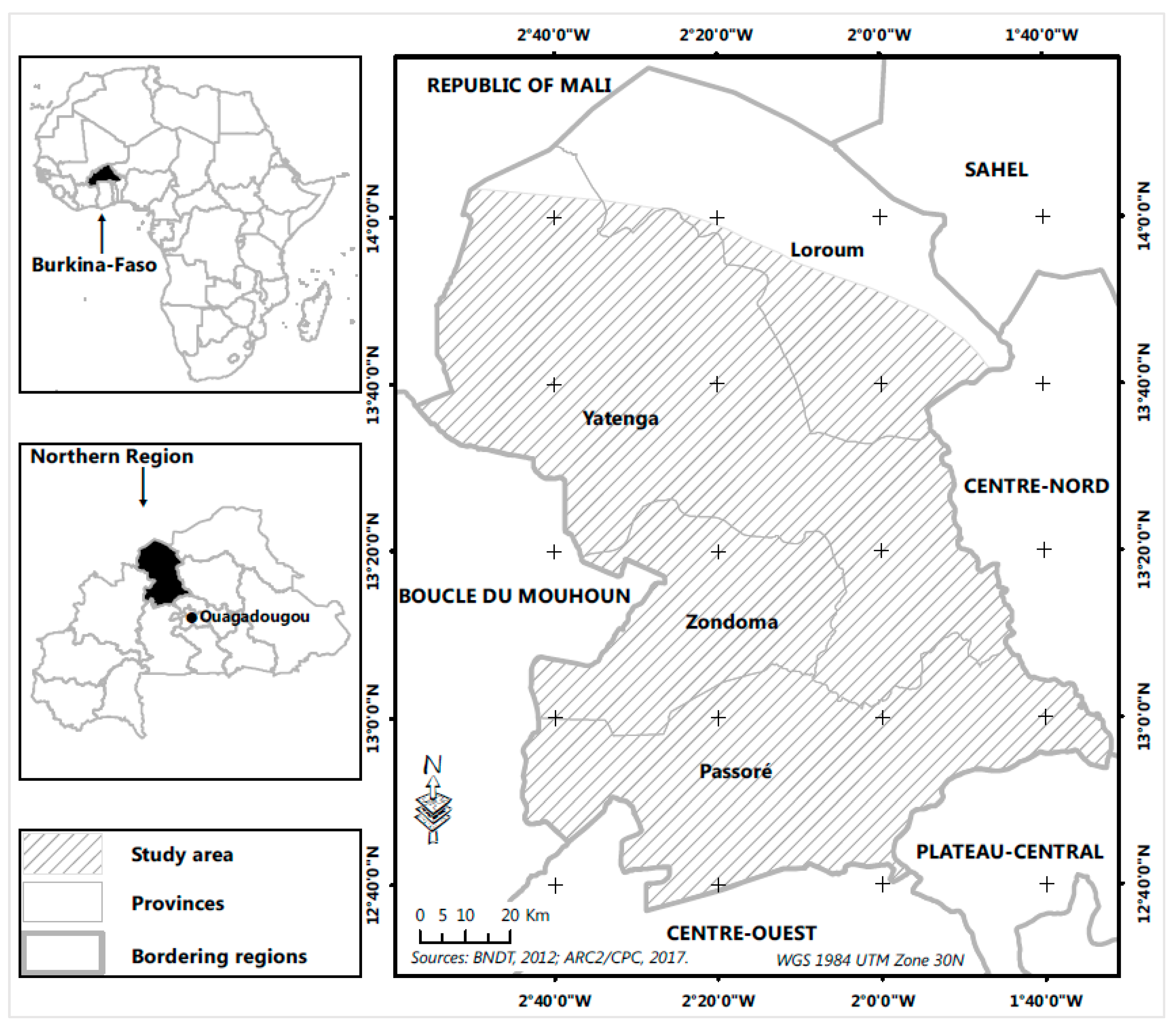
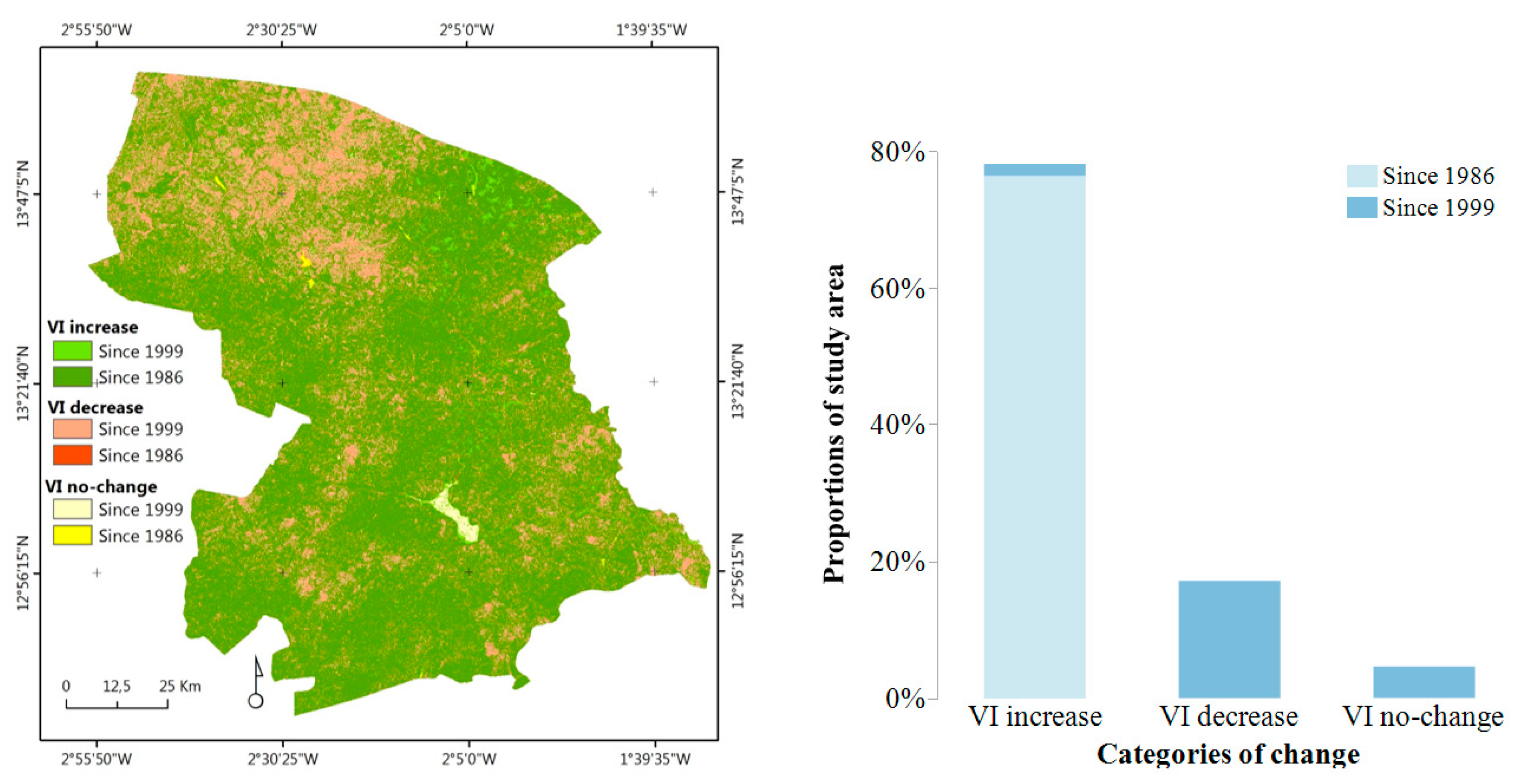
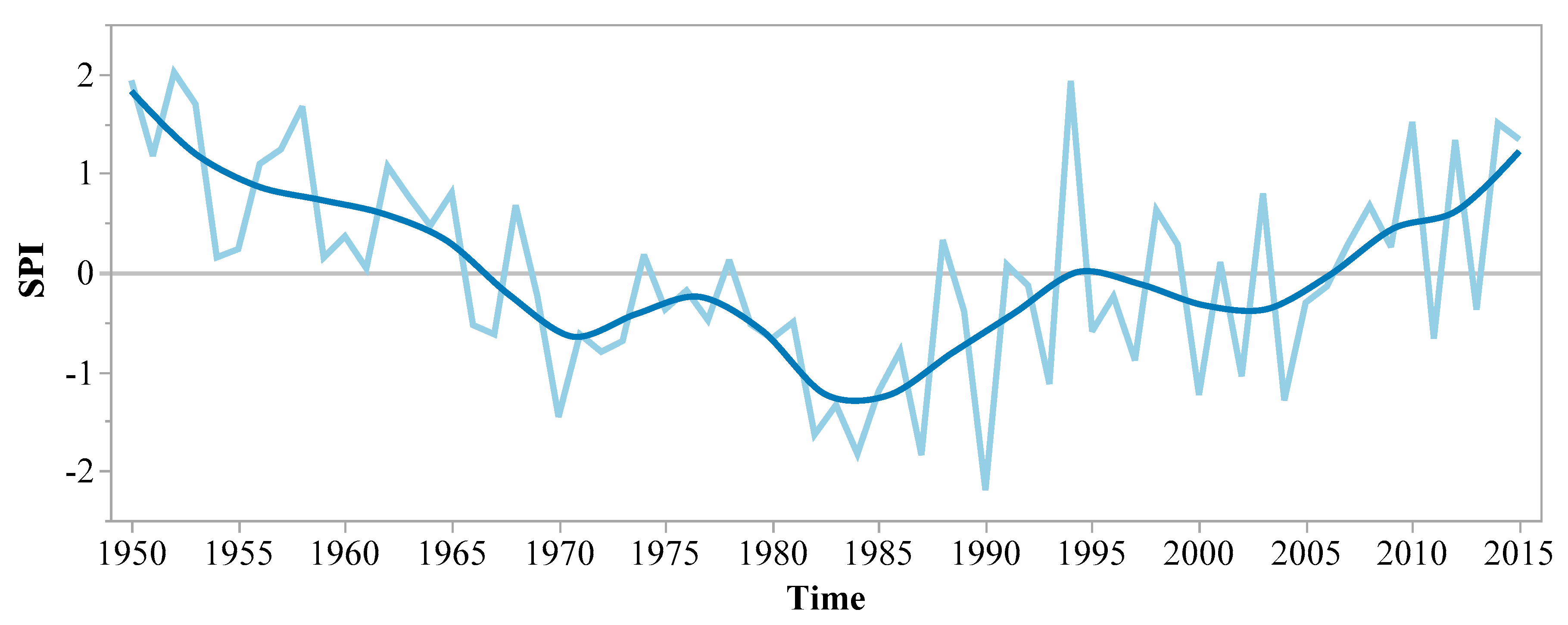
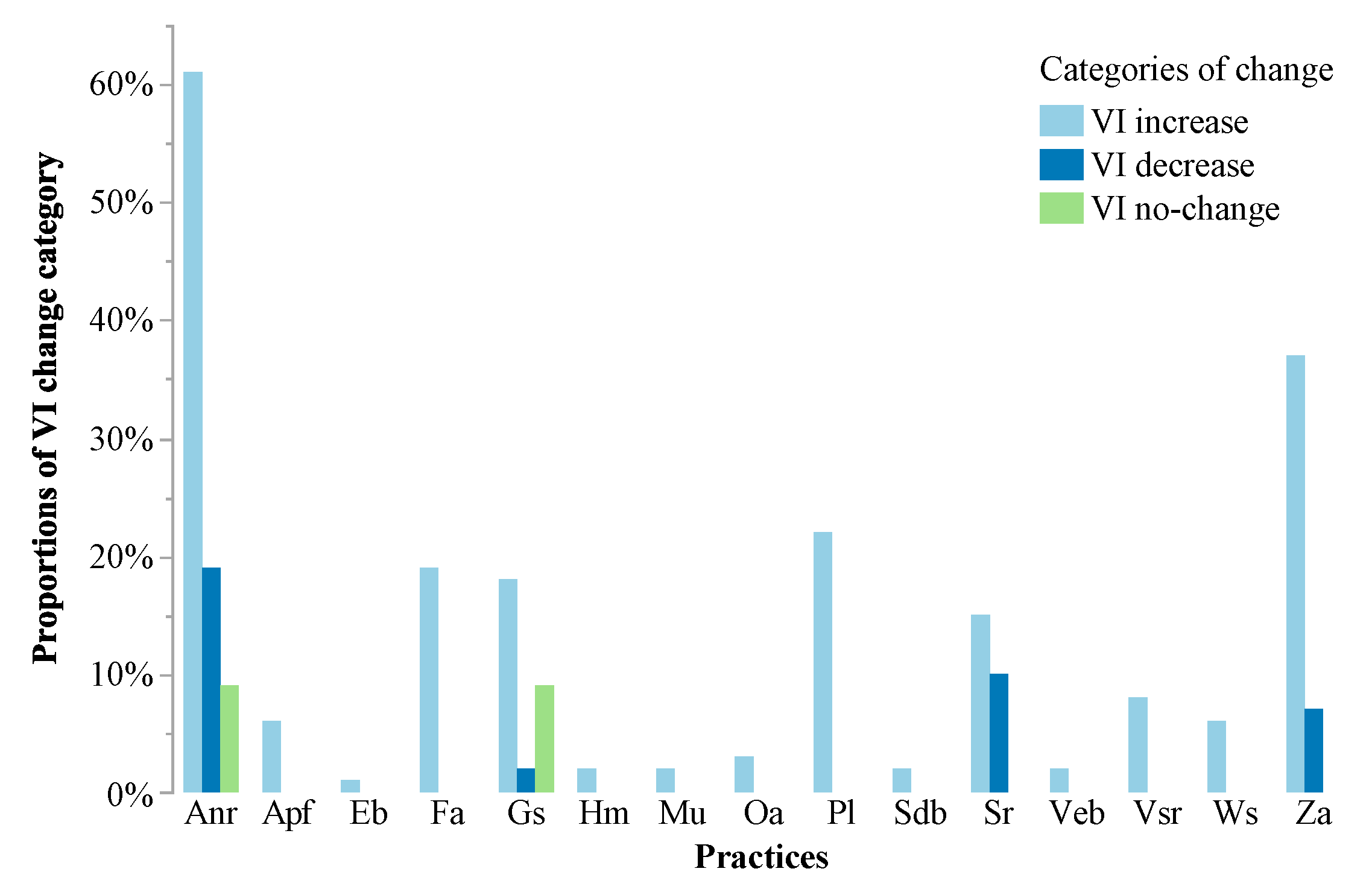
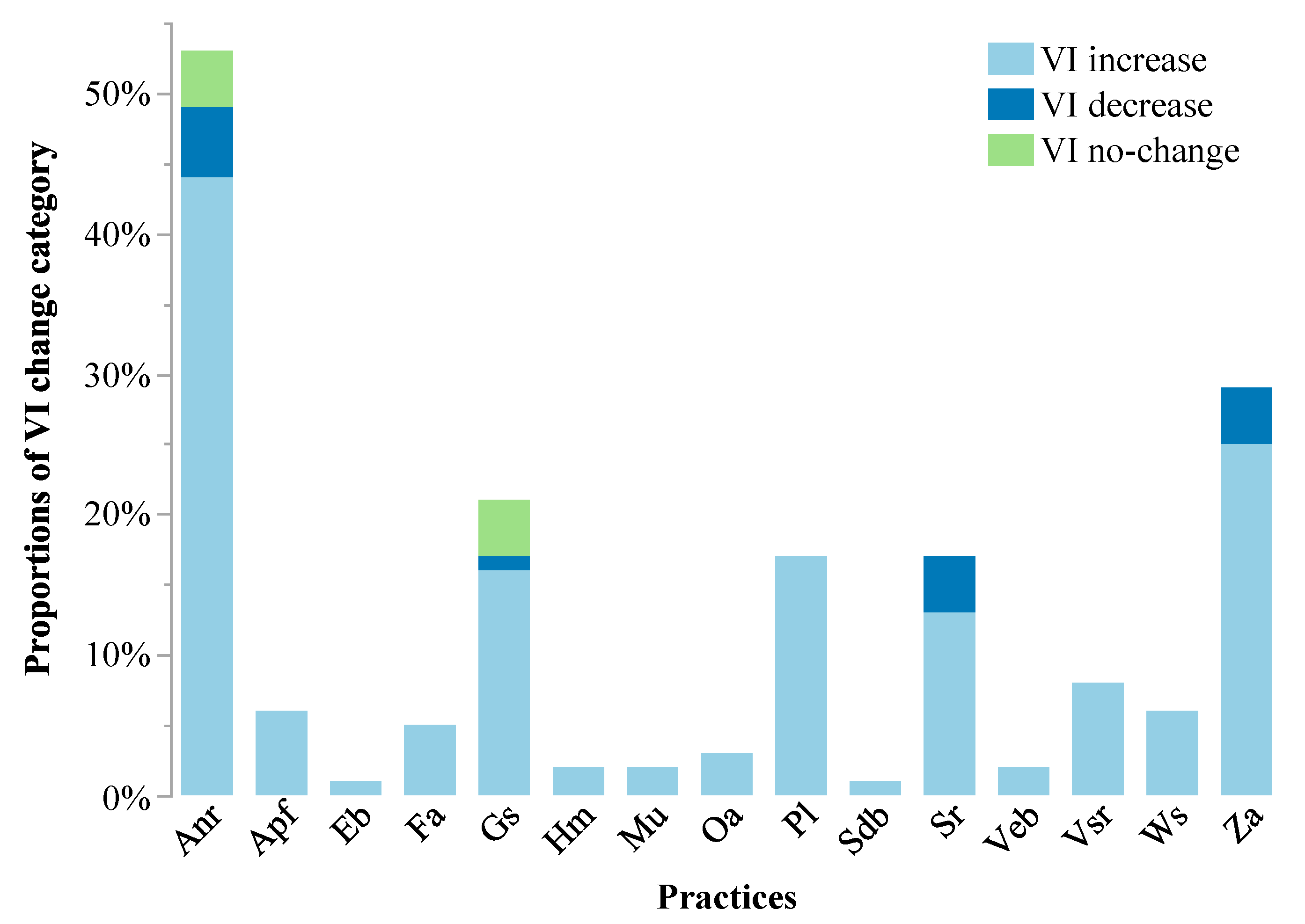
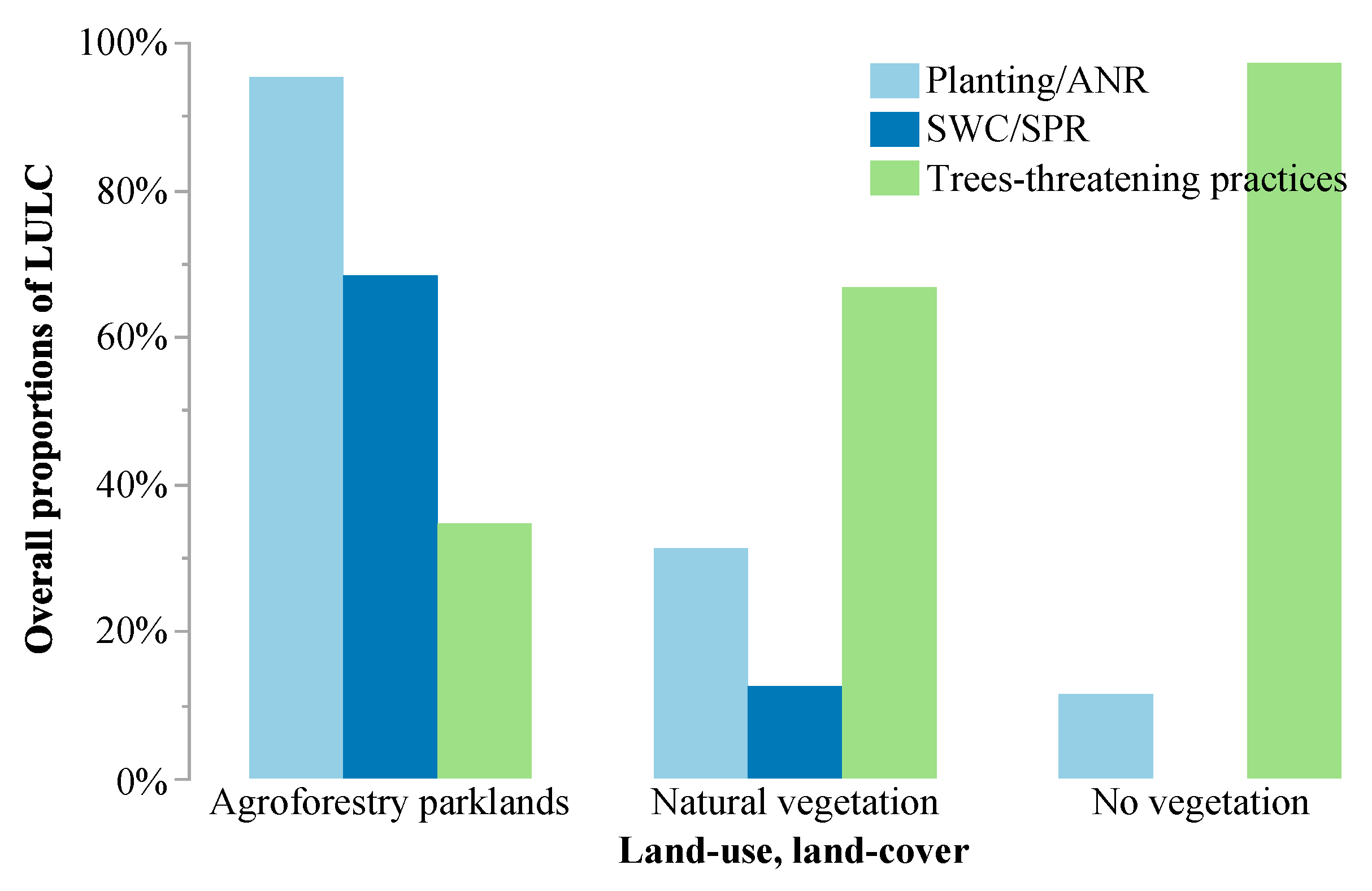
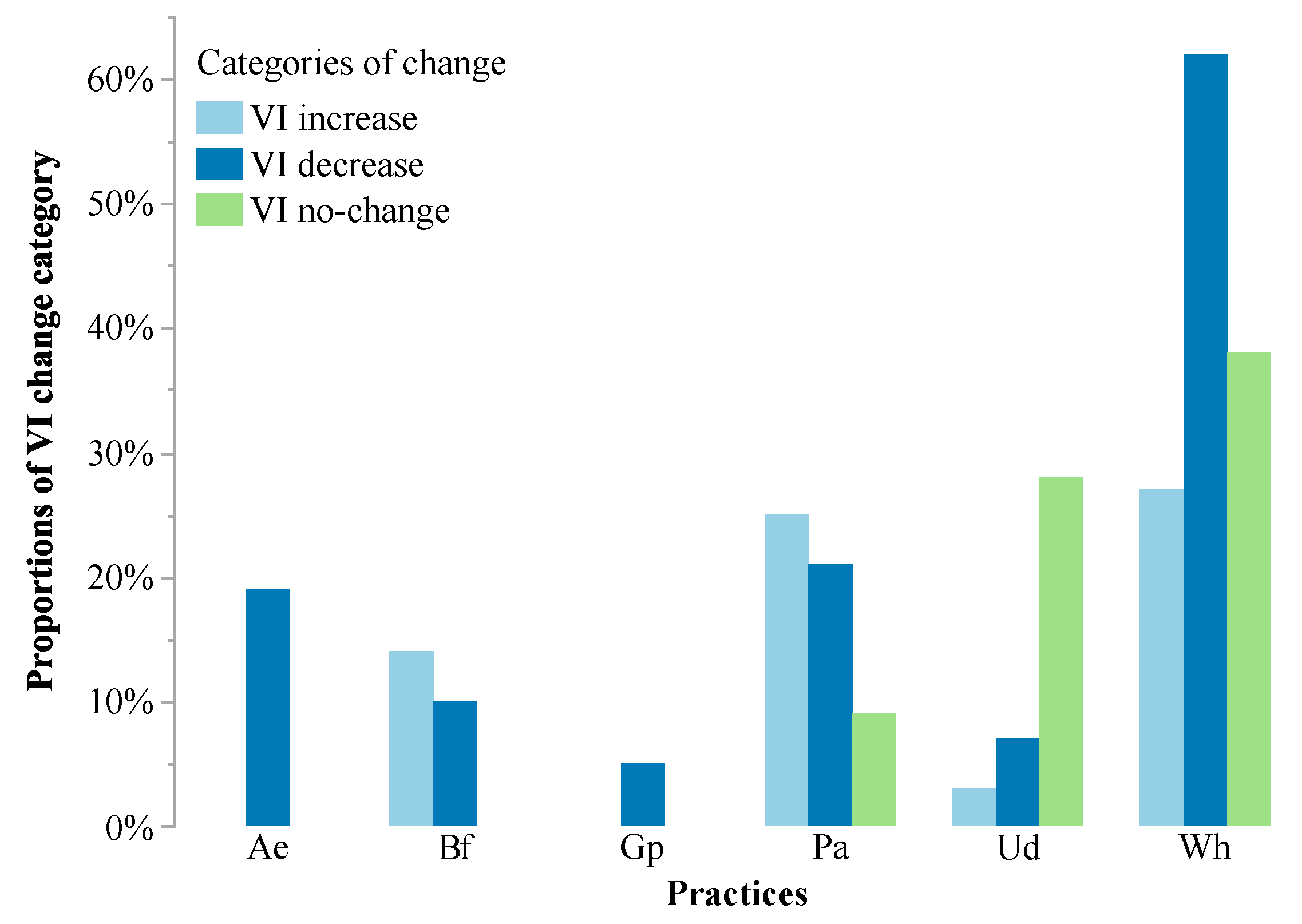
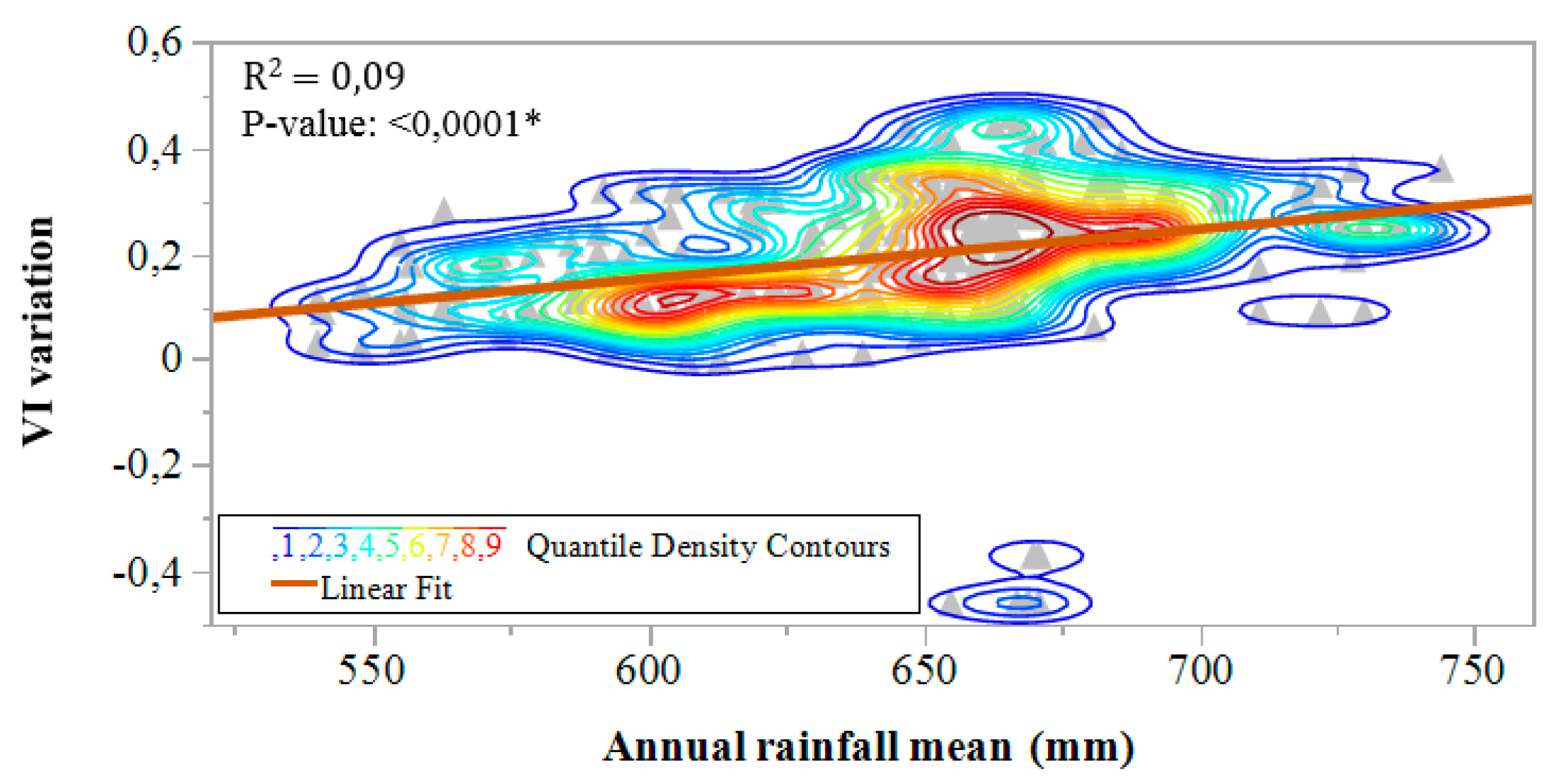
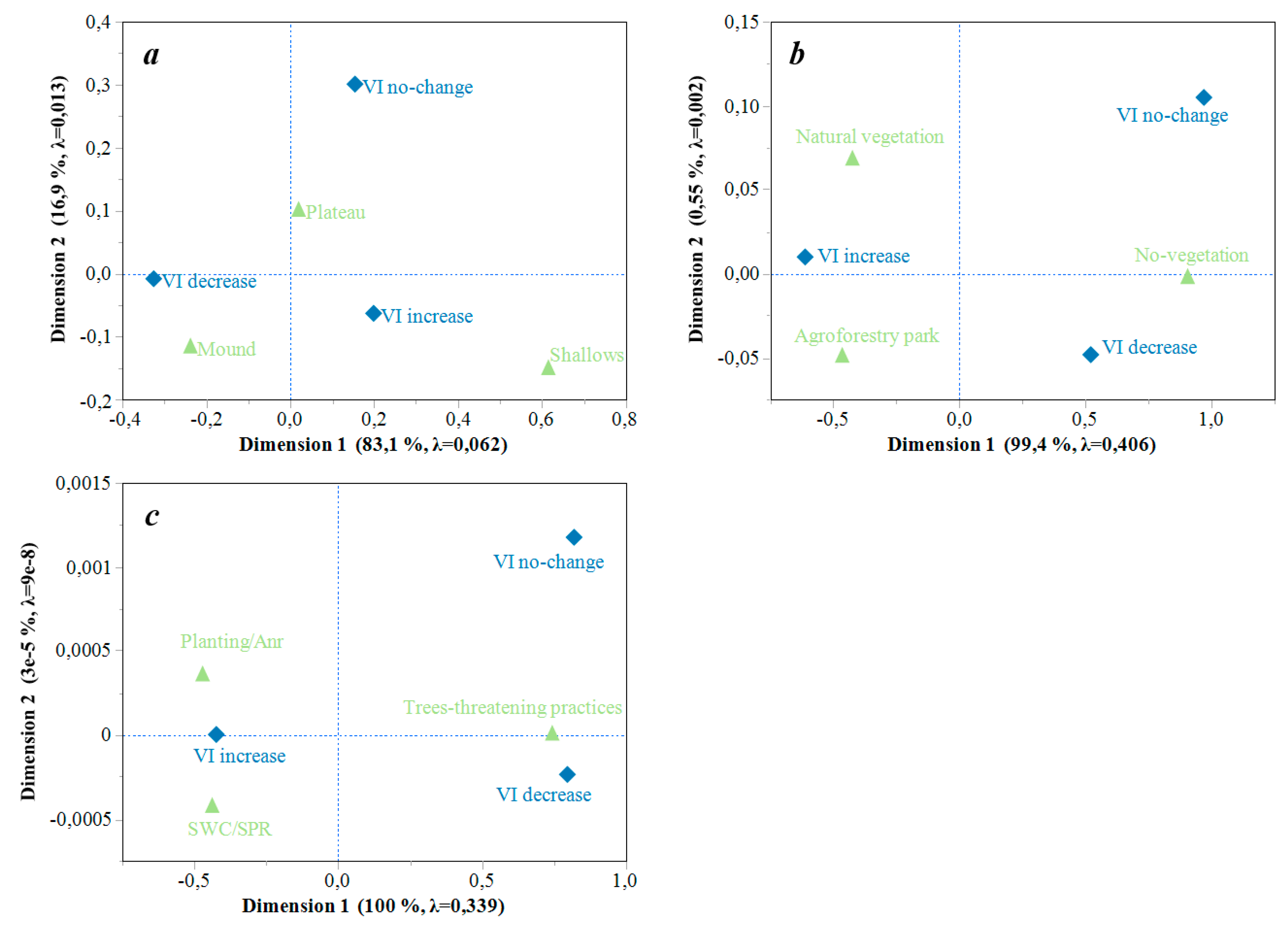
| Categories of Woody Plant Cover Change | Sequence of Change | p | 1−p | n | n Final | ||
|---|---|---|---|---|---|---|---|
| VI increase | Since 1999 | 1.76% | 98.24% | 3.8416 | 0.0064 | 10 | 118 |
| Since 1986 | 76.38% | 23.62% | 3.8416 | 0.0064 | 108 | ||
| VI decrease | Since 1999 | 17.11% | 82.89% | 3.8416 | 0.0064 | 85 | 85 |
| Since 1986 | 0.08% | 99.92% | 3.8416 | 0.0064 | 0 | ||
| VI no-change | Since 1999 | 4.55% | 95.45% | 3.8416 | 0.0064 | 26 | 27 |
| Since 1986 | 0.13% | 99.87% | 3.8416 | 0.0064 | 1 | ||
| Total | 100% | - | - | - | 230 | 230 | |
| Environmental Variables | Categories of Woody Plant Cover Change | Total | ||||||
|---|---|---|---|---|---|---|---|---|
| VI Increase | VI Decrease | VI No-Change | ||||||
| Number | % | Number | % | Number | % | Number | % | |
| Soils | ||||||||
| Ferruginous soils | 11 | 9% | 12 | 14% | 2 | 7% | 25 | 11% |
| Hydromorphic soils | 17 | 14% | 8 | 9% | 5 | 19% | 30 | 13% |
| Lithosols | 24 | 20% | 10 | 12% | 5 | 19% | 39 | 17% |
| Poorly evolved soils | 65 | 55% | 53 | 62% | 15 | 56% | 133 | 58% |
| Sodic soils | 1 | 1% | 2 | 2% | 0% | 3 | 1% | |
| Total | 118 | 100% | 85 | 100% | 27 | 100% | 230 | 100% |
| Geomorphology | ||||||||
| Mounds | 35 | 30% | 38 | 45% | 5 | 19% | 78 | 34% |
| Plateaus | 62 | 53% | 45 | 53% | 19 | 70% | 126 | 55% |
| Shallows | 21 | 18% | 2 | 2% | 3 | 11% | 26 | 11% |
| Total | 118 | 100% | 85 | 100% | 27 | 100% | 230 | 100% |
| Land Use, Land Cover | Categories of Woody Plant Cover Change | Total | ||||||
|---|---|---|---|---|---|---|---|---|
| VI Increase | VI Decrease | VI No-Change | ||||||
| Number | % | Number | % | Number | % | Number | % | |
| Agroforestry park | 65 | 55% | 22 | 26% | 2 | 7% | 89 | 39% |
| Bare land | 3 | 3% | 43 | 51% | 12 | 44% | 58 | 25% |
| Conserved area | 8 | 7% | 2 | 2% | 0% | 10 | 4% | |
| Habitation | 2 | 2% | 6 | 7% | 4 | 15% | 12 | 5% |
| Riparian forest | 2 | 2% | 0% | 2 | 7% | 4 | 2% | |
| Shrub savannah | 31 | 26% | 6 | 7% | 2 | 7% | 39 | 17% |
| Steppe | 5 | 4% | 6 | 7% | 0% | 11 | 5% | |
| Tree savannah | 1 | 1% | 0% | 0% | 1 | 0% | ||
| Water surfaces | 1 | 1% | 0% | 5 | 19% | 6 | 3% | |
| Total | 118 | 100% | 85 | 100% | 28 | 104% | 230 | 100% |
| Combinations No. | Practices | Number of Combinations Observed | |||||||
|---|---|---|---|---|---|---|---|---|---|
| VI Increase | VI Decrease | VI No-Change | |||||||
| 1 | Anr | Mu | Gs | Sr | Hm | Za | 1 | ||
| 2 | Anr | Pl | Gs | Sr | Za | 1 | |||
| 3 | Anr | Pl | Gs | Vsr | Za | 2 | |||
| 4 | Anr | Pl | Ws | Vsr | Za | 1 | |||
| 5 | Anr | Apf | Pl | Sr | 1 | ||||
| 6 | Anr | Apf | Sr | Za | 1 | ||||
| 7 | Anr | Apf | Vsr | Za | 1 | ||||
| 8 | Anr | Fa | Pl | Za | 1 | ||||
| 9 | Anr | Gs | Ws | Za | 1 | ||||
| 10 | Anr | Pl | Gs | Sr | 1 | ||||
| 11 | Anr | Mu | Gs | Za | 1 | ||||
| 12 | Anr | Pl | Gs | Za | 1 | ||||
| 13 | Anr | Pl | Sr | Za | 2 | ||||
| 14 | Anr | Pl | Vsr | Za | 1 | ||||
| 15 | Anr | Sdb | Eb | Sr | 1 | ||||
| 16 | Anr | Sr | Hm | Za | 1 | ||||
| 17 | Anr | Apf | Pl | 2 | |||||
| 18 | Anr | Apf | Sr | 2 | |||||
| 19 | Anr | Fa | Ws | 1 | |||||
| 20 | Anr | Fa | Za | 1 | |||||
| 21 | Anr | Gs | Sr | 1 | |||||
| 22 | Anr | Gs | Vsr | 1 | |||||
| 23 | Anr | Gs | Ws | 2 | |||||
| 24 | Anr | Gs | Za | 3 | |||||
| 25 | Anr | Oa | Gs | 1 | |||||
| 26 | Anr | Oa | Veb | 1 | |||||
| 27 | Anr | Pl | Gs | 1 | |||||
| 28 | Anr | Pl | Oa | 1 | |||||
| 29 | Anr | Pl | Za | 3 | |||||
| 30 | Anr | Sr | Za | 2 | 2 | ||||
| 31 | Anr | Veb | Za | 1 | |||||
| 32 | Anr | Vsr | Za | 3 | |||||
| 33 | Anr | Gs | 2 | 1 | |||||
| 34 | Anr | Oa | 1 | ||||||
| 35 | Anr | Pl | 2 | ||||||
| 36 | Anr | Ws | 2 | ||||||
| 37 | Anr | Za | 2 | 1 | |||||
| 38 | Fa | Gs | 1 | ||||||
| 39 | Fa | Sr | 2 | ||||||
| Total number of combinations | 55 | 4 | 1 | ||||||
| Frequency of the total number of samples | 47% | 5% | 4% | ||||||
| Environmental and Anthropogenic Variables | Pearson’s Chi-Squared Test (χ2) According to the Categories of Woody Plant Cover Change: VI Increase, VI Decrease, VI No-Change | |
|---|---|---|
| Chi-Square | Prob > ChiSq | |
| Soils | 2704 | 0.6084 |
| Geomorphology | 17,219 | 0.0018 * |
| Land use, land cover | 93,837 | <0.0001 * |
| Land-use practices | 160,818 | <0.0001 * |
© 2019 by the authors. Licensee MDPI, Basel, Switzerland. This article is an open access article distributed under the terms and conditions of the Creative Commons Attribution (CC BY) license (http://creativecommons.org/licenses/by/4.0/).
Share and Cite
Zida, W.A.; Bationo, B.A.; Waaub, J.-P. Effects of Land-Use Practices on Woody Plant Cover Dynamics in Sahelian Agrosystems in Burkina Faso since the 1970s–1980s Droughts. Sustainability 2019, 11, 5908. https://doi.org/10.3390/su11215908
Zida WA, Bationo BA, Waaub J-P. Effects of Land-Use Practices on Woody Plant Cover Dynamics in Sahelian Agrosystems in Burkina Faso since the 1970s–1980s Droughts. Sustainability. 2019; 11(21):5908. https://doi.org/10.3390/su11215908
Chicago/Turabian StyleZida, Wendpouiré Arnaud, Babou André Bationo, and Jean-Philippe Waaub. 2019. "Effects of Land-Use Practices on Woody Plant Cover Dynamics in Sahelian Agrosystems in Burkina Faso since the 1970s–1980s Droughts" Sustainability 11, no. 21: 5908. https://doi.org/10.3390/su11215908
APA StyleZida, W. A., Bationo, B. A., & Waaub, J.-P. (2019). Effects of Land-Use Practices on Woody Plant Cover Dynamics in Sahelian Agrosystems in Burkina Faso since the 1970s–1980s Droughts. Sustainability, 11(21), 5908. https://doi.org/10.3390/su11215908





